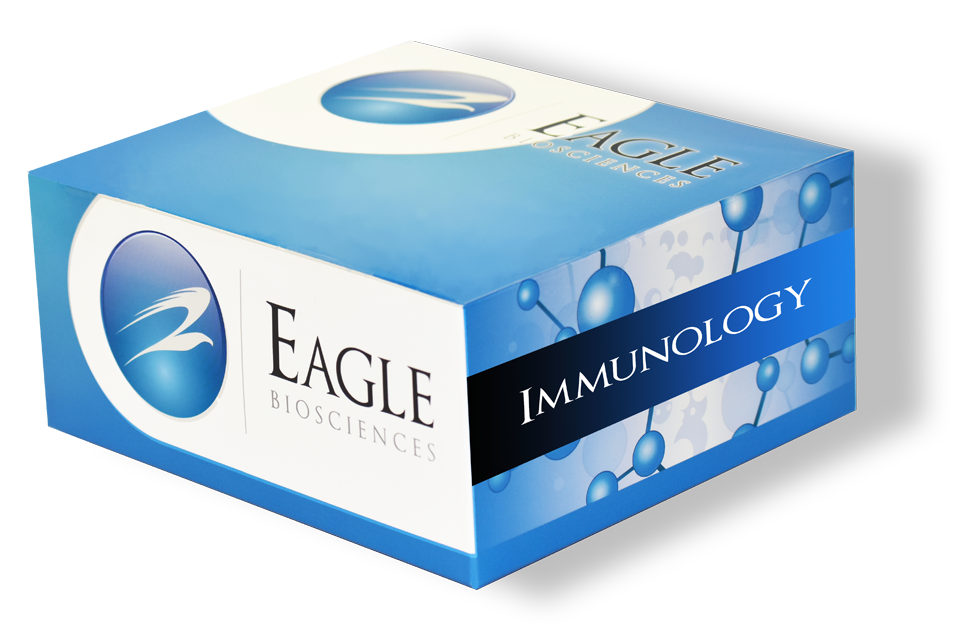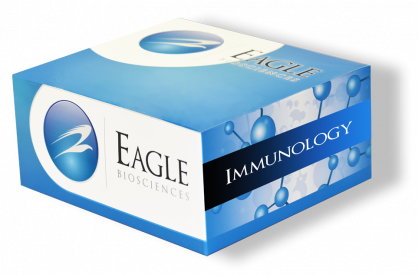Swine IFN-gamma ELISA Assay
The Swine IFN-gamma ELISA Assay is For Research Use Only
Size: 1×96 wells
Sensitivity: 7 pg/mL
Dynamic Range: 15.625 – 1000 pg/mL
Incubation Time: 3 hours
Sample Type: Serum, Plasma, Cell Culture
Sample Size: 100 µl
Alternative Names: Porcine Interferon Gamma, Porcine IFN-Gamma, Swine Interferon Gamma, IFN-g, Type II Interferon, IFN-γ
Assay Principle
The Swine Interferon Gamma (IFN-Gamma) ELISA Kit employs the quantitative sandwich enzyme immunoassay technique. A monoclonal antibody specific for IFN-gamma has been pre-coated onto a microplate. Standard, control, or sample and the working solution of Biotin-Conjugate are pipetted into the wells. Following incubation and wash steps any IFN-gamma present is bound by the immobilized antibody and the detection antibody specific for IFN-γ is binds to the combination of capture antibody- IFN-γ in sample. Following a wash to remove any unbound combination, and enzyme conjugate is added to the wells. Following incubation and wash steps a substrate is added. A colored product is formed in proportion to the amount of IFN-gamma present in the sample. The reaction is terminated by addition of acid and absorbance is measured at 450nm. A standard curve is prepared from seven IFN-γ standard dilutions and IFN-gamma sample concentration determined.
Related Products
Swine TNF-Alpha ELISA Assay Kit
Interferon Gamma ELISA Assay
Assay Procedure
- Prepare all reagents and working standards as directed in the previous sections.
- Determine the number of microwell strips required to test the desired number of samples plus appropriate number of wells needed for running blanks and standards. Remove extra microwell strips from holder and store in foil bag with the desiccant provided at 2-8°C sealed tightly.
- Add 100 µl of Standard, control, or sample, per well, then add 50 µl of the working solution of Biotin-Conjugate to each well. Cover with the adhesive strip provided and incubate 2 hours at RT. Adequate mixing is very important for good result. Use a mini-vortexer at the lowest frequency.
- Aspirate each well and wash, repeating the process three times for a total of four washes. Wash by filling each well with Wash Buffer (350 µl) using a squirt bottle, manifold dispenser or auto-washer. Complete removal of liquid at each step is essential to good performance. After the last wash, remove any remaining Wash Buffer by aspirating or decanting. Invert the plate and blot it against clean paper towels.
- Add 100 µl of the working solution of Streptavidin-HRP to each well. Cover with a new adhesive strip and incubate for 30 minutes at RT Avoid placing the plate in direct light.
- Repeat the aspiration/wash.
- Add 100 µl of Substrate Solution to each well. Incubate for 10-20 minutes at RT. Avoid placing the plate in direct light.
- Add 100 µl of Stop Solution to each well. Gently tap the plate to ensure thorough mixing.
- Determine the optical density of each well immediately, using a microplate reader set to 450 nm.(optionally 630nm as the reference wave length;610-650nm is acceptable)
Assay Background
Interferon-gamma (IFN-g, also known as type II interferon) is an important immunoregulatory cytokine that was originally identified because of its anti-viral activity (1). It plays key roles in host defense by exerting antiviral, antiproliferative and immunoregulatory activities (2 – 5). On many cell types, IFN-g induces the production of cytokines and upregulates the expression of various membrane proteins including class I and II MHC antigens, Fc receptors, leukocyte adhesion molecules and B7 family antigens. IFN-g is a potent activator of macrophage effector functions. It potentiates the secretion of immunoglobulins by B cells, and directs the synthesis of IgG. IFN-g also influences T-helper cell phenotype development by inhibiting Th2 differentiation and stimulating Th1 development (2 – 5). Finally, IFN- promotes mononuclear cell chemotaxis by inducing the synthesis of CXCL9, CXCL10, CCL2, CCL3, CCL4, and CCL5(3). IFN-g is produced by a number of cell types, including dendritic epidermal/ T cells (6), keratinocytes (7), peripheral blood T cells (8), mast cells (9), neurons (10), CD8 T cells (11), macrophages (12), B cells (13), and neutrophils (14), NK cells (15), CD4 T cells (16) and testicular spermatids (17). The production of IFN-g is upregulated synergistically by IL-12, IL-18, IL-23 and IL-27 (18 – 21). Porcine IFN-g cDNA encodes a 166 amino acid (aa) residue precursor protein with a 20 aa signal sequence that is cleaved to generate a 146 aa residue mature IFN-g (22, 23). Porcine IFN-g is presumably a noncovalently linked homodimer (3). In the mature segment, porcine IFN-g shares 60%, 55%, 41%, 42%, 72%, and 72% aa sequence identity with human (24), guinea pig (25), mouse (26), rat (27), feline (28), and canine (29) IFN-g, respectively. The functional IFN-g receptor complex consists of two distinct subunits (30). The alpha subunit (IFN-gR1) binds IFN-g with high affinity and species specificity. The beta-subunit [IFN-gR2, also known as accessory factor-1 (AF-1)] interacts with the IFN- occupied-subunit in a species-specific manner and participates in JAK-STAT mediated signal transduction. Although the functional receptor is suggested to consist of homodimeric IFN-g in combination with two-chains, and two-chains (30, 31), it has been suggested that additional subunits may be involved (32, 33). Whereas the α-chain is expressed constitutively on many cell types, the cellular regulation of the β-chain correlates with an IFN-g responsive state and is tightly regulated (30).
Documents
Product Manual
Please note: All documents above are for reference use only and should not be used in place of the documents included with this physical product. If digital copies are needed, please contact us.
Publications
Citations
Ren, J;Lu, H;Wen, S;Sun, W;Yan, F;Chen, X;Jing, J;Liu, H;Liu, C;Xue, F;Xiao, P;Xin, S;Jin, N;, Enhanced immune responses in pigs by DNA vaccine coexpressing GP3 and GP5 of European type porcine reproductive and respiratory syndrome virus, Journal of Virol. Methods, Volume 206C, Page 27-37, https://www.sciencedirect.com/science/article/pii/S0166093414002134
References
1. Wheelock, E.F. (1965) Science 146:310.
2. Billiau, A. (1996) Adv. Immunol. 62:61.
3. Schroder, K. et al. (2004) J. Leukoc. Biol. 75:163.
4. Paludan, S.R. (1998) Scand, J. Immunol. 48:459.
5. Boehm, U. et al. (1997) Annu. Rev. Immunol. 15:749.
6. Sugaya, M. et al. (1999) J. Invest. Dermatol. 113:350.
7. Howie, S.E.M. et al. (1996) J. Invest. Dermatol. 106:1218.
8. Battistini, L. et al. (1997) J. Immunol. 159:3723.
9. Gupta, A.A. et al. (1996) J. Immunol. 157:2123.
10. Neumann, H. et al. (1997) J. Exp. Med. 186:2023.
11. Hoiden, I. and G. Moller (1996) Scand. J. Immunol. 44:501.
12. Puddu, P. et al. (1997) J. Immunol. 159:3490.
13. Yoshimoto, T. et al. (1997) Proc. Natl. Acad. Sci. USA 94:3948.
14. Yeaman, G.R. et al. (1998) J. Immunol. 160:5145.
15. Asea, A. et al. (1996) Clin. Exp. Immunol. 105:376.
16. Briscoe, D.M. et al. (1997) J. Immunol. 159:3247.
17. Dejuco, N. et al. (1995) Endocrinology 136:4925.
18. Lebel-Binay, S. et al. (2000) Eur. Cytokine Netw. 11:15.
19. Trinchieri, G. (2003) Nat. Rev. Immunol. 3:133
20. Gracie, J.A. et al. (2003) J. Leukoc. Biol. 73:213.
21. Lankford, C.S.R. and D.M. Frucht (2003) J. Leukoc. Biol. 73:49.
22. Dijkmans, R. et al. (1990) Nucleic Acids Res. 18:4259.
23. Vandenbroeck, K. et al. (1991) Biochem. Biophys. Res. Commun. 180:1408.
24. Gray, P.W. and D.V. Goeddel (1982) Nature 298:859.
25. Jeevan, A. et al. (2003) Inf. Immun. 71:354.
26. Gray, P.W. and D.V. Goeddel (1983) Proc. Natl. Acad. Sci. USA 80:5842.
27. Dijkema, R. et al. (1985) EMBO J. 4:761.
28. Schijns, V.E. et al. (1995) Immunogenetics 42:440.
29. Zucker, K. et al. (1992) J. Interferon Res. 12:191.
30. Bach, E.A. et al. (1997) Annu. Rev. Immunol. 15:563.
31. Marsters, S.A. et al. (1995) Proc. Natl. Acad. Sci. USA 92:5401.
32. Thiel, D.J. et al. (2000) Structure 8:927.
33. Lembo, D. et al. (1996) J. Biol. Chem. 271:32659.
34. Bradford, M.M. (1976) Anal. Biochem. 72:248.


